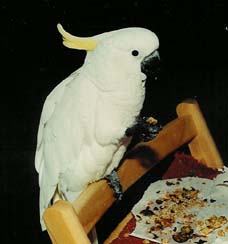My friend Meredith and I were near the end of our Saturday birdwalk at the Coyote Hills Regional Park wetlands along the San Francisco Bay shoreline. The November morning was crisp, and we’d enjoyed the usual show of white-crowned sparrows, egrets, an array of ducks. Hungry now, we sat down beside the trail along a woodsy stretch and pulled out bag lunches.
We were halfway through our sandwiches when we heard a loud cawk! in the underbrush. Cawk! Caaawk! Screeeeeee!
I looked at Meredith. She would recognize the call; after all, she was the one who had taught me birding. But her eyes glinted alarm; this was no bird she recognized. And by the sound of it, the creature was huge. And drawing closer.
We froze. Then the underbrush parted, and there, climbing beak over claws down the last shrubby barrier, was a pure white cockatoo. He–it was indeed a “he,” we later learned–made a beeline for us, hopped up on my leg, and looked up at me expectantly.
Our hearts melted. An abandoned bird. A tropical bird with clipped wings, fending for himself on one of the coldest nights of the year. Hurriedly we broke off pieces of our sandwich bread. He gobbled up each bite. We poured water into the lids of our bottles. He dipped his head and drank, lifting his head again and again to swallow. His pearly white feathers glowed in the diffuse light, then he stretched and opened his bright yellow crest to its full height.
We were in love. How could anyone abandon such a beautiful, responsive creature in a park?
Over the following days I got a clue.
When “Pearly” came home with me I found that he needed constant attention. Left to himself, he would roam the apartment, searching for pieces of wood–chair legs, futon frames, table edges–to chew. Not to mention emitting earsplitting shrieks. Early each morning my dog and I were frightened out of sleep by his banshee screams.
But one thing never failed to quiet him. If I softly stroked the top of his regal head, his eyes would unfocus and he’d lapse into silence, sitting transfixed for hours on end. So we made our peace: he perched on the arm of my computer chair, and I wrote my dissertation by pecking at the keyboard with one hand while stroking his head with the index finger of the other. At mealtime I poured some nuts onto a paper towel, and he sat on the back of a dining chair, nibbling daintily at each nut grasped in his claw.
An ad in local papers failed to turn up anyone looking for a cockatoo, so I began searching for a new home for him. Yes, I did consider keeping him; Pearly had won my heart, or at least part of it. But caring for him was like minding a two-year-old, and cockatoo experts assured me that Pearly, like all cockatoos, would remain like a two-year-old for the rest of his seventy-year-long life.
Thankfully, there are cockatoo rescue groups in the Bay Area, and before long I was packing Pearly into the car for the drive across town. He perched atop the back of the passenger seat, chattering softly at the passing view. But when we entered a tunnel and all went dark, Pearly flitted abruptly to my right shoulder and huddled tight against my ear. Only after daylight broke could I persuade him to move over and let me drive safely again.
Feeling both sad and relieved, I handed Pearly over to join a squawking community of parrots and cockatoos climbing up and down huge open cages in a softly shaded backyard that looked like cockatoo heaven. Pearly seemed immediately at home, crawling happily up his own jungle gym and picking up a wooden toy to chew. Some weeks later I called the kind woman who ran the bird rescue, and she told me that Pearly had been placed with a solitary older woman who took great pleasure in his company.
That was a dozen years ago. But Pearly made such a dent that today, when I sat down to write about something else, it’s Pearly’s story that wanted to be told.
Here’s to you, Pearly. You did a great job finding yourself a home.